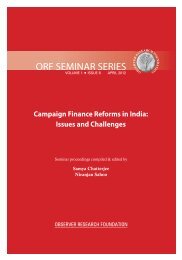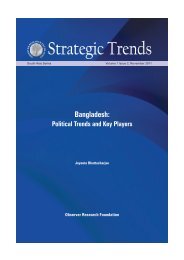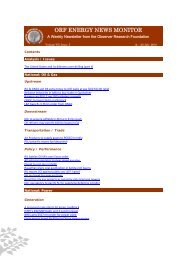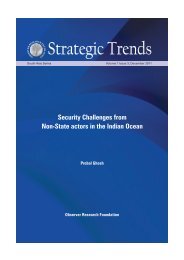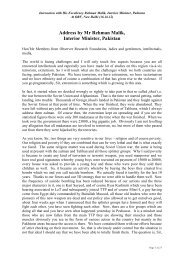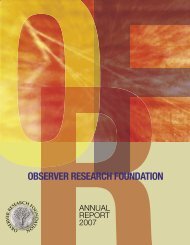Produced and Published by Observer Research Foundation 1 Vol. II ...
Produced and Published by Observer Research Foundation 1 Vol. II ...
Produced and Published by Observer Research Foundation 1 Vol. II ...
Create successful ePaper yourself
Turn your PDF publications into a flip-book with our unique Google optimized e-Paper software.
In accordance with international<br />
law, the limit of the territorial sea is<br />
set at 12 nautical miles². China<br />
claims sovereignty over most of the<br />
isl<strong>and</strong>s in the SCS as its territory.<br />
As such, its adjacent waters up to<br />
12 nautical miles will be considered<br />
as China’s territorial sea. According<br />
to article 6 of China’s 1992<br />
territorial law: “Foreign ships for<br />
non-military purposes shall enjoy<br />
the right of innocent passage<br />
through the territorial sea of the<br />
People's Republic of China in<br />
accordance with the law” <strong>and</strong> that<br />
“Foreign ships for military<br />
purposes shall be subject to<br />
approval <strong>by</strong> the Government of the<br />
People's Republic of China for<br />
entering the territorial sea of the<br />
People's Republic of China.” In<br />
November 2012, it was reported<br />
that China has enabled its police to<br />
board <strong>and</strong> search ships which<br />
illegally enter what China considers<br />
its territory in the disputed waters.<br />
The move was heavily critised <strong>and</strong><br />
caused consternation in the<br />
international community as it<br />
concerned the busy lanes of the<br />
South China Sea. There were two<br />
incidents with Indian vessels in the<br />
South China Sea hinting at Chinese<br />
assertiveness in claiming the SCS as<br />
its internal waters. The first was in<br />
July 2011, when INS Airavat was<br />
contacted on radio saying that it<br />
was “entering Chinese waters”<br />
while sailing on the South China<br />
Sea. Responding to the reports, the<br />
Ministry of External Affairs (India)<br />
released a statement on September<br />
2011 explaining the incident. The<br />
statement read<br />
The Indian Naval vessel,<br />
INS Airavat paid a friendly<br />
visit to Vietnam between 19<br />
to 28 July 2011. On July 22,<br />
INS Airavat sailed from the<br />
Vietnamese port of Nha<br />
Trang towards Hai Phong,<br />
where it was to make a port<br />
call. At a distance of 45<br />
nautical miles from the<br />
Vietnamese coast in the<br />
South China Sea, it was<br />
contacted on open radio<br />
channel <strong>by</strong> a<br />
caller identifying himself as<br />
the "Chinese Navy” stating<br />
that "you are entering<br />
Chinese waters.<br />
The second incident was in June<br />
2012, when the People’s Liberation<br />
Army Navy (PLAN) provided an<br />
unwelcomed escort to the Indian<br />
naval squadron led <strong>by</strong> INS Shivalik<br />
in the waters of the South China<br />
Sea. As reported, “Although the<br />
Indian ships were in international<br />
waters, a Chinese frigate sent a<br />
message "welcoming" the<br />
contingent to the South China Sea<br />
<strong>and</strong> sailed along for the next 12<br />
hours”. Analysing the situation,<br />
strategic expert Dr. C. Raja Mohan<br />
explained: “The message is this:<br />
"nice to see you here, but you are<br />
in our territorial waters <strong>and</strong> within<br />
them there is no right to 'freedom<br />
of navigation' for military vessels.<br />
You are here at our sufferance."<br />
China’s attempt to levy its national<br />
laws on international waters is<br />
alarming to the international<br />
community. It is essential that all<br />
nations’ observer international laws<br />
<strong>and</strong> norms for free passage of<br />
vessels in international waters.<br />
India’s Defence Minister A.K<br />
Antony underlined the need to<br />
abide <strong>by</strong> international laws at the<br />
2012 Shangri-La Dialogue. He<br />
emphasised that “Like individual<br />
freedoms, the fullness of maritime<br />
freedoms can be realised only when<br />
all states, big <strong>and</strong> small, are willing<br />
to abide <strong>by</strong> universally agreed laws<br />
<strong>and</strong> principles”. S.M. Krishna,<br />
India’s then External Affairs<br />
Minister expressed similar views at<br />
the ASEAN Regional Forum<br />
(ARF). Observing the vitality of<br />
SLOCs, the minister stated that<br />
“We have been following<br />
developments in respect to the<br />
South China Sea. As we had stated<br />
earlier, India supports freedom of<br />
navigation <strong>and</strong> access to resources<br />
in accordance with principles of<br />
international law. These principles<br />
should be respected <strong>by</strong> all.”<br />
Tensions in the region have<br />
heightened due to assertive <strong>and</strong><br />
aggressive claims on the disputed<br />
isl<strong>and</strong>s. It is imperative that all<br />
nations follow the norms of<br />
international law to avoid conflict.<br />
India is keen to make its presence<br />
felt in the region <strong>and</strong> is willing to<br />
cooperate with the Southeast Asian<br />
countries to ensure maritime<br />
freedom.<br />
The Indian Navy plans periodic<br />
deployments in the South China<br />
Sea to mark its presence. It also<br />
engages in exercises with the navies<br />
of the Southeast Asian nations.<br />
India’s cooperation with the<br />
Southeast Asian nations is in<br />
keeping with its Look East Policy.<br />
India <strong>and</strong> ASEAN in December<br />
2012 commemorated the 20 th<br />
anniversary of the ASEAN-India<br />
Dialogue Relations. The Summit<br />
saw the adoption of the vision<br />
statement, an important<br />
development in the India-ASEAN<br />
relations. The vision statement<br />
marked India <strong>and</strong> the ASEAN<br />
nations’ commitment to ensure<br />
FON. The statement read “We are<br />
<strong>Produced</strong> <strong>and</strong> <strong>Published</strong> <strong>by</strong> <strong>Observer</strong> <strong>Research</strong> <strong>Foundation</strong><br />
9



